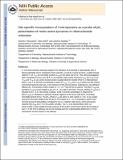Site-Specific Incorporation of 3-Nitrotyrosine as a Probe of pK[subscript a] Perturbation of Redox-Active Tyrosines in Ribonucleotide Reductase
Author(s)
Yokoyama, Kenichi; Uhlin, Ulla; Stubbe, JoAnne
DownloadStubbe_Site-specific.pdf (862.5Kb)
PUBLISHER_POLICY
Publisher Policy
Article is made available in accordance with the publisher's policy and may be subject to US copyright law. Please refer to the publisher's site for terms of use.
Terms of use
Metadata
Show full item recordAbstract
E. coli ribonucleotide reductase catalyzes the reduction of nucleoside 5′-diphosphates into 2′-deoxynucleotides and is composed of two subunits: α2 and β2. During turnover, a stable tyrosyl radical (Y•) at Y[subscript 122-]β2 reversibly oxidizes C[subscript 439] in the active site of α2. This radical propagation step is proposed to occur over 35 Å, to use specific redox-active tyrosines (Y[subscript 122] and Y[subscript 356] in β2, Y[subscript 731] and Y[subscript 730] in α2), and to involve proton-coupled electron transfer (PCET). 3-Nitrotyrosine (NO[subscript 2]Y, pK[subscript a] 7.1) has been incorporated in place of Y[subscript 122], Y[subscript 731], and Y[subscript 730] to probe how the protein environment perturbs each pK[subscript a] in the presence of the second subunit, substrate (S), and allosteric effector (E). The activity of each mutant is <4 × 10[subscript −3] that of the wild-type (wt) subunit. The [NO[subscript 2]Y[subscript 730]]-α2 and [NO[subscript 2]Y[subscript 731]]-α2 each exhibit a pK[subscript a] of 7.8−8.0 with E and E/β2. The pK[subscript a] of [NO[subscript 2]Y[subscript 730]]-α2 is elevated to 8.2−8.3 in the S/E/β2 complex, whereas no further perturbation is observed for [NO[subscript 2]Y[subscript 731]]-α2. Mutations in pathway residues adjacent to the NO[subscript 2]Y that disrupt H-bonding minimally perturb its pK[subscript a]. The pK[subscript a] of NO[subscript 2]Y[subscript 122-]β2 alone or with α2/S/E is >9.6. X-ray crystal structures have been obtained for all [NO[subscript 2]Y]-α2 mutants (2.1−3.1 Å resolution), which show minimal structural perturbation compared to wt-α2. Together with the pK[subscript a] of the previously reported NO[subscript 2]Y[subscript 356-]β2 (7.5 in the α2/S/E complex; Yee, C. et al. Biochemistry 2003, 42, 14541−14552), these studies provide a picture of the protein environment of the ground state at each Y in the PCET pathway, and are the starting point for understanding differences in PCET mechanisms at each residue in the pathway.
Date issued
2010-06Department
Massachusetts Institute of Technology. Department of Biology; Massachusetts Institute of Technology. Department of ChemistryJournal
Journal of the American Chemical Society
Publisher
American Chemical Society (ACS)
Citation
Yokoyama, Kenichi, Ulla Uhlin, and JoAnne Stubbe. “Site-Specific Incorporation of 3-Nitrotyrosine as a Probe of pK[subscript a]Perturbation of Redox-Active Tyrosines in Ribonucleotide Reductase.” Journal of the American Chemical Society 132.24 (2010): 8385–8397.
Version: Author's final manuscript
ISSN
0002-7863
1520-5126